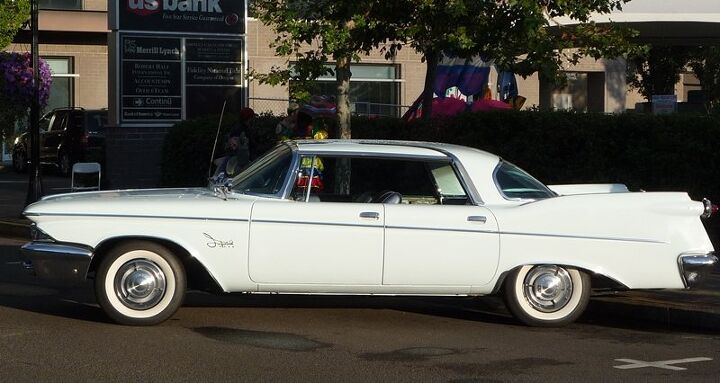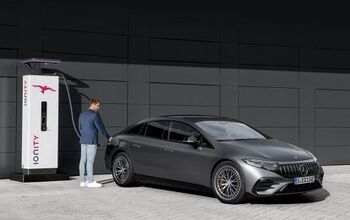Curbside Classic: 1960 Imperial Crown Southampton – The Frankenstein Of Cars

Calling a car from this period a monster is not exactly uncommon or uncalled for. But what if its own daddy called it that? Virgil Exner, the father of the definitive automotive fins created a sensation in 1957 when they appeared on the all-new “ Suddenly it’s 1960” models. With a straight face, Exner then claimed they were rooted in aerodynamics and highly functional. But with the ’57s he painted himself into a corner; there was no where further to go with them except ever greater absurdity, quickly turning them into caricatures of themselves. Even Exner admitted as much: “by 1959, it was obvious that I’d given birth to a Frankenstein”. I credit him for his honesty, if not good taste.
Let’s briefly take in the Frankenstein in its full glory, then jump back three years to where it all started.
The 1957 Chryslers were probably the finest of the Mopar crop that year, their fins being the best expression of Exner’s bold new look. In addition to the alleged aerodynamic benefits, Exner saw the fins as away to dramatically change the poise of his cars. His son Virgil Exner Jr. speaks for his father’s intentions: “The idea of the fin was to get some poise to the rear of the cars, to get them off of the soft, rounded back-end look, to achieve lightness.”
These ’57s were certainly dramatically ahead of the competition in terms of length, lowness, width and of course fins. And they work quite well here, given the objectives of that moment, questionable as it was.
Exner was a creative designer whose two main influences were the Italian school of design, especially the Alfa Romeo BAT cars, and the classic era of the thirties such as the Duesenberg. The perpetual battleground of integrating such disparate influences plays out repeatedly in his work, for better or for worse. The truth be told, he was a bit of a two-hit wonder with the 1955-56 and the 1957 Chryslers. Everything that followed until he left in 1961 was problematic, exacerbating Chrysler’s other issues at the time.
The 1957 Imperial was a bold and expensive gamble by Chrysler to challenge the near-monopoly that Cadillac enjoyed in the fifties. Lincoln was struggling with its own design issues, and the Imperial was certainly years ahead of the pathetic ‘ 57 Cadillacs, even if it wasn’t quite as harmonious a design as the Chryslers (note: this was during the time when Imperial was a separate brand from Chrysler).
The ’57 Imperial even got its own distinct body shell, unlike previous and later Imperials. One of its most unique features was curved side glass, an industry first. There was no question; the ’57 Imperial was the most advanced of the luxury cars when it appeared, in the context of that moment in time. But like all of Exner’s cars, it was a bit over the top, and not everyone’s taste. Sales tripled in 1957 over the prior year, reaching 35k, an all-time high water mark for both its fins and Imperial sales ever.
Of course, the rampant quality problems of all ’57 Chrysler products did not escape the Imperial. and the deep recession of 1958 created a remarkable change in attitude. Suddenly yesterday’s rocket ships became giant finned monsters overnight, now being seen the same light that over-leveraged MacMansions are today. A recession can be a remarkably sobering experience.
Imperial sales dropped by over 50%, and the whole upper end sector took a huge bruising as everyone clamored for Ramblers and VWs. Imperial sold 18k cars in 1960 to Cadillac’s 143k, so maybe it wasn’t all the recession, but perhaps in part to that ridiculous fake spare tire “toilet seat” that showed up in 1958. This was Exner’s jumping the shark moment, although I know some will disagree. You’re wrong! What a hodge-podge of mish-mashes. Suddenly it’s 1974!
At least Imperial didn’t drop as much as Lincoln; their disastrous over-the-top 1958 models dropped Lincoln into the number three sales slot of the luxury brands. For two brief years, Imperial savored silver, even if sales were in the toilet of its own making.
The failure of the Imperials to properly catch on put them into weird sort of limbo: from 1957 through 1966, they used the same basic body shell, despite ever more desperate efforts to conceal that fact. But there was a royal give-away: that very expensive compound curve windshield. Chrysler could screw around with a fin here and a floating headlight there, but it was stuck with that distinctive tell-tale windshield for way too long. I figured this out in real time, and each fall as the new cars came out, there it was: that same damn windshield. It wasn’t until 1967, when Imperials went back to using a slightly disguised Chrysler body that it finally disappeared.
When the rest of the Chrysler family switched to unibodies in 1960, the Imperial got a pass. Ostensibly because the frame gave it a quieter ride, the real reason was that Chrysler couldn’t afford to spend anything more than nickles and dimes on the slow selling Imperial during its 1957-1966 body era. Hence the tell-tale windshield.
If this 1960 Imperial is a Frankenstein, than what is its 1961 successor (above)? That’s when Exneruberance started to really go off the deep end, marrying the free-standing headlights inspired from his beloved classic era with the tail end of the fin era. And free-standing taillights to go along, no less. But freaks can be so lovable; I’ll take one home, thank you.
Consider that by 1961 the rest of the industry had already moved on, and even Cadillac fins had returned to earth. The rest of Caddy’s clean and trimmer new looks, never mind the stunning new ’61 Continental made the former leading-edge Imperial look like a retro-mobile, the forerunner of the seventies’ customs like the Bugazzi and such.
After Exner departed, former Ford designer Elwood Engel was brought in to subdue and tone down the the monsters. His reskin of the old ’57 body added very ’61 Lincolnesque slab sides to the ’65 Imperial, but still there’s that old wrap-around windshield again, looking very out of date by then.
Seems like we’ve talked about everything but this 1960. Well, it was an interim year, just before the floating headlights, but the fins were already well past their prime. As a compensation, there’s a quite dramatic dashboard to savor, including those push buttons for the TorqueFlite transmission.
Let’s not shortchange Chrysler’s squared-off steering wheel, which was as prescient of future tillers as the fins. Looking out over it was presumably easier, to better appreciate the acreage under which sat Chrysler’s 413 CID wedge V8, which replaced the legendary and legendarily expensive to build hemi a couple of years earlier. With a 350 hp rating, the big wedge did everything the hemi could but even better, except to power a dragster after it was yanked out of its first role in life.
A Frankenstein the 1960 Imperial may well be, but we all loved that monster too. Now it’s hard to fathom how such bizarreness was once considered elegant and chic. Stranger things have happened, but not that many more than the 1960 Imperial.

More by Paul Niedermeyer
Latest Car Reviews
Read moreLatest Product Reviews
Read moreRecent Comments
- Honda1 Unions were needed back in the early days, not needed know. There are plenty of rules and regulations and government agencies that keep companies in line. It's just a money grad and nothing more. Fain is a punk!
- 1995 SC If the necessary number of employees vote to unionize then yes, they should be unionized. That's how it works.
- Sobhuza Trooper That Dave Thomas fella sounds like the kind of twit who is oh-so-quick to tell us how easy and fun the bus is for any and all of your personal transportation needs. The time to get to and from the bus stop is never a concern. The time waiting for the bus is never a concern. The time waiting for a connection (if there is one) is never a concern. The weather is never a concern. Whatever you might be carrying or intend to purchase is never a concern. Nope, Boo Cars! Yeah Buses! Buses rule!Needless to say, these twits don't actual take the damn bus.
- MaintenanceCosts Nobody here seems to acknowledge that there are multiple use cases for cars.Some people spend all their time driving all over the country and need every mile and minute of time savings. ICE cars are better for them right now.Some people only drive locally and fly when they travel. For them, there's probably a range number that works, and they don't really need more. For the uses for which we use our EV, that would be around 150 miles. The other thing about a low range requirement is it can make 120V charging viable. If you don't drive more than an average of about 40 miles/day, you can probably get enough electrons through a wall outlet. We spent over two years charging our Bolt only through 120V, while our house was getting rebuilt, and never had an issue.Those are extremes. There are all sorts of use cases in between, which probably represent the majority of drivers. For some users, what's needed is more range. But I think for most users, what's needed is better charging. Retrofit apartment garages like Tim's with 240V outlets at every spot. Install more L3 chargers in supermarket parking lots and alongside gas stations. Make chargers that work like Tesla Superchargers as ubiquitous as gas stations, and EV charging will not be an issue for most users.
- MaintenanceCosts I don't have an opinion on whether any one plant unionizing is the right answer, but the employees sure need to have the right to organize. Unions or the credible threat of unionization are the only thing, history has proven, that can keep employers honest. Without it, we've seen over and over, the employers have complete power over the workers and feel free to exploit the workers however they see fit. (And don't tell me "oh, the workers can just leave" - in an oligopolistic industry, working conditions quickly converge, and there's not another employer right around the corner.)










































Comments
Join the conversation
Nochrysler, the reason for the square steering wheel was to make for easier entry/exit, and more room for the legs while driving. Those were the days before tilt steering columns. As the owner of a 63 Imperial Lebaron 4 door hardtop I have magazine road tests of late 50's to early 60's Imps. They got great reviews, and blew the lincolns and caddies away in many categories, espeically in performance and handling. I also own a 73 lebaron 4 door and 78 new yorker brougham 2 door.
http://www.imperialclub.com/Articles/60MotorLife/Page04-reg.jpg